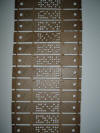On
another page on this site, I talked about compressed prime number
modulo tables. To construct one of these, you establish a square
array of cells. Each cell going across the table represents a sequential integer,
and it's lit up if that integer is a prime number. The horizontal
"wrapping" width of the table (the row width) is selected as a multiplicand of
the first few primes. I used 30 = 2 X 3 X 5 in my examples. Then
you throw away all the "dead" columns -- that is, the ones that show up
without any primes in them -- and compress the "live" ones so that they are
right next to each other. With a starting 30-modulo table, you end up
with 8 "prime-live" columns. It ends up looking like the table to the
right:
 On
that earlier page, I noted how the resulting "compressed" prime tables looked
a lot like the old antique Jacquard loom programming card strips. I
wondered what kind of weave pattern you would get if you used these prime
tables on such a loom. An image of one of these programming card strips
is shown to the left. (I bought this strip from somewhere a bunch of
years ago; I think it was from a Cracker Barrel Restaurant store in NC.
It makes for an unusual wall hanging!)
On
that earlier page, I noted how the resulting "compressed" prime tables looked
a lot like the old antique Jacquard loom programming card strips. I
wondered what kind of weave pattern you would get if you used these prime
tables on such a loom. An image of one of these programming card strips
is shown to the left. (I bought this strip from somewhere a bunch of
years ago; I think it was from a Cracker Barrel Restaurant store in NC.
It makes for an unusual wall hanging!)
Well, I don't really know how
these looms worked, or how the programming cards actually governed the
shuttles, thread warp and woof, and so on. But I figured I would go
ahead and make my own imaginary tapestries from these "prime tables" as if
they were used to directly produce a weave pattern. I made the total
image symmetrical by inverting, mirroring and copying the initially drawn 8 X
60 prime table
section. Here are some examples I obtained when doing this. In
these images, the cells are colored according to how "dense" the prime cells
were around any given cell in the table. In other words, the tapestry
colors are established according to how many prime number cells are in the 8
neighboring cells around each target cell -- those 8 being the "compass star"
around that cell, N, NE, E, SE, S, SW, W, and NW. These tapestries are
made with the upper left starting cell integer equal to 1, 15001, 1500001,
15000001, 1500000001, 15000000001, 150000000001, 1500000000001, 15000000000001, 150000000000001,
1500000000000001, respectively. Each tapestry requires evaluation of 8
(columns) X 60 (rows) = 480 integers in the "seed" table. My Intel 1.8 GHZ CPU
was just about ready to bog down on that last one -- so I stopped my tapestry weaving
at that point.
The prime factoring
test routine I use is as follows:
For n=[starting integer to ending integer]
b = Int(Sqr(n) + 1)
pr = 1
'assume the number is prime
For i = 2 To
b
If n/ i =
Int(n / i) Then 'if no remainder
pr = 0 'fails the prime test
i=b 'so
stop the testing loop
End If
Next
'Put your cell
plotting routine here, prime if pr=1
Next
Upon inspection,
you'll see that this routine can be made a lot more efficient. For
example, if the number being tested is not even (divisible by 2), it's
wasteful to continue to test it with other even divisors. So it'd be
better to pre-check the number for evenness, then continue the test with odd
divisors only (i.e., the test loop being: For i=3 to b Step 2). That
simple enhancement could cut the testing time in half. But heck, with a
fast CPU it's not a big deal -- so long as you're not testing extremely large
numbers.
If you are going to
explore regions as high up as I did (150 trillion or more), you will have to
declare your variable types (using VisualBasictm) as "variants".
Otherwise, they will give up the ghost, and your VB application will wander
off towards its original home in Redmond, Washington (where Bill Gates keeps
the VB "Main Loop" carefully hidden in his personal safe).
Notice that you
only have to test up to the square root of n. If it ain't factorable by
then, it'll be a prime number.
These tapestry
plots remind me a little of carpets woven in Turkey. I like those
because they use a lot more geometric shapes and patterns than in Persian,
Belgian or other types of carpets. Or maybe they evoke Mayan or Incan
designs?
You can definitely
see how the primes start to get sparser as the region of interest gets higher.
But they are always there!
